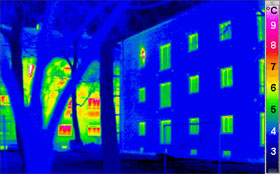Environmental concerns
Carbon emissions
One of the major environmental impacts of buildings is their contribution to carbon dioxide emissions and global warming. 30% of all the carbon emissions in the country - some 40 million tonnes each year - comes from housing. 60% of this is caused by central heating, 25% by hot water, and the remainder by electrical appliances, lighting and cooking.
While changes in Building Regulations have helped to slow the rise in emissions, in 2006 the Government announced its ambition that all new housing should be carbon-neutral by 2016. Much of the technology to achieve this is already available, and we are already able to construct your home to be close to carbon neutral today, for example by building to the AECB Gold Energy Standard™. While this will inevitably add to the construction costs, it will also increase comfort and cut your future energy bills.
Embodied energy
Due to the length of time your home will be standing, cutting carbon emissions throughout it's lifetime should be your top design priority. However, constructing the house from materials which have been manufactured, transported and assembled using low inputs of energy is a further consideration.
We therefore have a preference for using materials that have been sourced from our region, and which themselves have low embodied energy. It is however necessary to balance this against the longevity and the physical characteristics and functions of the materials and products. Clay bricks, for example, may need to be chosen to meet planning requirements, even though they contain high levels of embodied energy from the firing process.
Water use
South East England, and in particular Cambridgeshire and Essex, experience the lowest average rainfall in the United Kingdom. With pressure from an increasing population and from climate change, cutting the amount of water used helps safeguard supplies, minimises expenditure on new infrastructure, and cuts energy and carbon emissions.
Your home can be designed to minimise water use in a number of ways. Showers can be installed, aerators fitted to taps will mix air with the water to cut the need for a high water flow, WCs with a low volume flush can be used, and your washing machine can be chosen for water -as well as energy - efficiency.
The water from your bathroom sink can also be captured and used to flush the WC. It is also easy to capture the rainwater from your roof in underground tanks, using it for the washing machine, WC or garden.
Flooding
As more land is developed, so more rainwater is diverted into sewers and rivers, adding to the potential to cause flooding. Capturing this water in underground tanks for use in your home cuts the amount of water discharged.
Alternatively, it may be possible to plant a living 'green roof' on your home. This can absorb some of the rainwater, while also providing a habitat for plants and insects.
Deforestation
Illegal logging and poor forest management can cause a wide spectrum of ecological and social damage, from destroying wildlife habitats and causing soil erosion, to funding armed conflict and increasing global warming.
We are committed to using timber from sustainable sources certified by the Forest Stewardship Council. The Forest Stewardship Council certifies that timber has been sourced from sustainably managed forests, and provides one of the best guarantees that the timber is ecologically sound.
Carbon emissions, rising energy prices, gas shortages, water shortages, flooding, heatwaves, deforestation, depletion of resources, increases in allergies and asthma. Such issues are of growing concern to many people.
The Eco Design and Build team are committed to tackling these kinds of issues now, through the homes we build. We design and construct eco-friendly homes that are designed to reduce their impact on the environment, helping you to live more sustainably and healthily.

